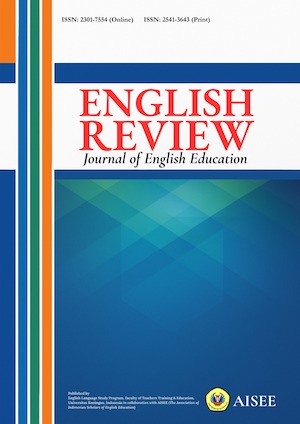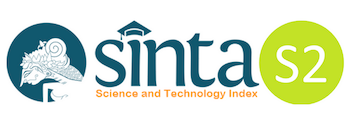INNOVATION OF WEB BASED ENGLISH LEARNING MEDIA DEVELOPMENT
Abstract
SMP Negeri 1 Garawangi Kuningan is one of junior high schools that uses manual English learning media such as books and paper for learning evaluation. This manual learning system will raise many problems such as longer time consuming the assessment process, moreover, the use of books and paper allows tearing or damage, and it leads to teacher-centered learning process that can make students bored and reduce student learning interest. Therefore, innovation in the development of web-based English learning media for junior high school students is needed. This web-based innovation helps students to learn and understand English after school hours. The target achieved in this study is the production of English learning application that is interesting, easy to understand, and easy to use. This study uses a qualitative descriptive method because it is based on data from direct observation and the theoretical basis of learning media. Meanwhile, for the system development method, Extreme Programming that is consisting of 4 stages i.e., planning design, coding, and testing is used in the study. The result of this study shows that this application of English learning media is accepted to be used by students to learn English after school hours.
References
Asikin, N. A. (2017). The analysis of interlanguage produced by 3rd grade high school students in narrative writing text. Indonesian EFL Journal, 3(1), 39-44.
Creswell, J. W., & Creswell, J. D. (2018). Research design: Qualitative, quantitative, and mixed methods approaches (5th ed.). Sage.
Darsih, E., & Asikin, N. A. (2020). Mobile assisted language learning: EFL learners’ perceptions toward the use of mobile applications in learning English. English Review: Journal of English Education, 8(2), 183-194. 10.25134/erjee.v8i2.2999
Elola, I., & Oskoz, A. (2018). Virtual worlds and language learning: A review of the literature. Language Learning & Technology, 22(2), 1-27
Erwin, E., & Anik, S. (2016). Development of Web-Based Learning Media for Natural Science Subjects for Class VII Students. Jurnal Pendidikan Fisika dan Teknologi, 2(2), 120-126.
Greenit. (2018). Software testing tutorial: Free course on manual testing and automation testing. Guru99. https://www.guru99.com/software-testing.html
Hamdan, A. R., Nawfal, N. K., & AlShammari, A. S. (2018). Gamification and English language learning: A study on the impact of points on learning. International Journal of Emerging Technologies in Learning (iJET), 13(12), 165-182.
Heni, S., & Hary, S. (2017). Development of web-based learning media to measure student learning outcomes in basic computer network subjects computer and network engineering expertise program. International Journal of Applied Engineering Research, 12(23), 13552-13560.
Januarisman, E., & Ghufron, A. (2016). Development of web-based learning media for natural science subjects and for grade VII students. Journal of Educational Technology Innovation, 7(3), 166-182.
Kirkwood, A., & Price, L. (2013). Missing: Evidence of a scholarly approach to teaching and learning with technology in higher education. Teaching in Higher Education, 18(3), 327-337.
Kukulska-Hulme, A. (2016). Language learning defined by time and place: A framework for next generation designs. International Journal of Mobile and Blended Learning, 8(1), 1-16.
Levy, M., & Stockwell, G. (2006). CALL Dimensions: Options and issues in computer-assisted language learning. Routledge.
Li, J., & Li, Y. (2018). Exploring the role of online communities in web-based English learning media development and their impact on learner motivation and engagement. Education and Information Technologies, 23(2), 675-691.
Maesyaroh, S. (2019). Application of the analytical hierarchy process method to determine expertise programs at SMK Model Patriot IV Ciawigebang Kuningan. Informatics Buffer, 5(1), 13-24.
Nikolov, M., & Mihaljević Djigunović, J. (2019). Language learning and digital technology. John Benjamins Publishing Company.
Putra, Y. I., & Ridoh, A. (2021). Development of web-based learning media to improve student skills in basic web programming courses at STKIP Muhammadiyah Muara Bungo. Basicedu Journal, 5(2), 4026-4036.
Sari, H. V., & Suswanto, H. (2017). Development of web-based learning media to measure student learning outcomes in basic computer network subjects in the computer and network engineering expertise program. Education Journal, 6(6), 1008-1016.
Stockwell, G., & Hubbard, P. (2013). Some emerging principles for mobile-assisted language learning. The International Research Foundation for English Language Education (TIRF) Annual Review, 1, 1-18.
Supriyatna, A. (2018). Development of an online English learning media using extreme programming. Journal of Physics: Conference Series, 1028(1), 012074. 10.1088/1742-6596/1028/1/012074
Thomas, M. (2016). An overview of the latest trends in web-based English language learning media. TESOL International Journal, 11(2), 43-57.
Traxler, J. (2016). Mobile learning and learning analytics: Capturing the evidence, integrating experience, informing practice. In Mobile Learning Analytics (pp. 1-17). Springer International Publishing.
Wang, Y., Chen, N. S., Liang, T. H., & Chen, W. F. (2018). Exploring the impact of social media on web-based English learning media development and its potential to facilitate collaborative learning and peer interaction. Australasian Journal of Educational Technology, 34(1), 82-97.
Yogi, Y., & Ahmad, M. (2021). Development of web-based learning media to improve student skills in basic web programming courses at STKIP Muhammadiyah Muara Bungo. Jurnal Pendidikan: Teori, Penelitian, dan Pengembangan, 6(1), 32-39.
Yuniarti, E., Asikin, Y., & Thamrin, T. (2021). Development of English language learning media on the interactive e-book for junior high school students. Edcomtech Jurnal Kajian Teknologi Pendidikan, 5(1), 23-33.
Zheng, D., & Cheng, Y. (2018). Personalized learning in Web 3.0 era: The role of mobile applications. British Journal of Educational Technology, 49(6), 1044-1055.
All articles published in English Review: Journal of English Education (ERJEE) are licensed under the Creative Commons Attribution 4.0 International License (CC BY 4.0).
Copyright Ownership
Authors retain the copyright of their articles and grant ERJEE the right of first publication. The journal is granted a non-exclusive license to publish, reproduce, and distribute the article in any format, medium, or platform, provided that proper credit is given to the original authors.
License Terms – CC BY 4.0
Under the Creative Commons Attribution 4.0 International License, others are free to:
- Share — copy and redistribute the material in any medium or format
- Adapt — remix, transform, and build upon the material for any purpose, even commercially
As long as they:
- Provide appropriate credit to the original author(s) and source
- Provide a link to the license (https://creativecommons.org/licenses/by/4.0/)
- Indicate if any changes were made
There are no restrictions on the reuse, reproduction, or adaptation of published articles as long as attribution is properly given.
Author Warranties
By submitting a manuscript to ERJEE, authors confirm that:
- The work is original and does not infringe any existing copyright.
- The manuscript has not been previously published and is not under consideration elsewhere.
- All sources and references are appropriately acknowledged.
- Necessary permissions have been obtained for any copyrighted materials used.









